Related Research Articles

The .460 Weatherby Magnum is a belted, bottlenecked rifle cartridge, developed by Roy Weatherby in 1957. The cartridge is based on the .378 Weatherby Magnum necked up to accept the .458-inch (11.6 mm) bullet. The original .378 Weatherby Magnum parent case was inspired by the .416 Rigby. The .460 Weatherby Magnum was designed as an African dangerous game rifle cartridge for the hunting of heavy, thick skinned dangerous game.

A wildcat cartridge, often shortened to wildcat, is a custom cartridge for which ammunition and/or firearms are not mass-produced. These cartridges are often created in order to optimize a certain performance characteristic of an existing commercial cartridge, or may merely be intended as novelty items.
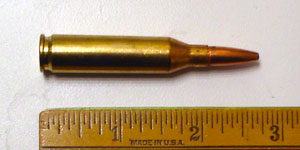
The .243 Winchester (6×52mm) is a popular sporting rifle cartridge. Developed as a versatile short action cartridge to hunt both medium game and small game alike, it "took whitetail hunting by storm" when introduced in 1955, and remains one of the most popular whitetail deer cartridges. It is also commonly used for harvesting blacktail deer, pronghorns and mule deer with heavier rounds, and is equally suited to varmint hunting with lighter rounds. The .243 is based on a necked down .308 Winchester, introduced only three years earlier. Expanding monolithic copper bullets of approximately 80 to 85 grains or traditional lead rounds of 90 to 105 grains with controlled expansion designs are best suited for hunting medium game, while lighter rounds are intended for varmints.
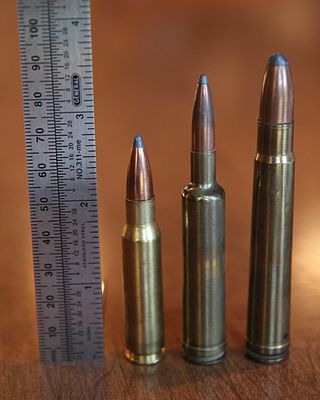
The .257 Weatherby Magnum is a .257 caliber (6.53 mm) belted bottlenecked cartridge. It is one of the original standard length magnums developed by shortening the .375 H&H Magnum case to approx. 2.5 in (64 mm). Of the cartridges developed by Roy Weatherby, the .257 Weatherby Magnum was known to have been his favorite, and the cartridge currently ranks third in Weatherby cartridge sales, after the .30-378 Weatherby Magnum and the .300 Weatherby Magnum.
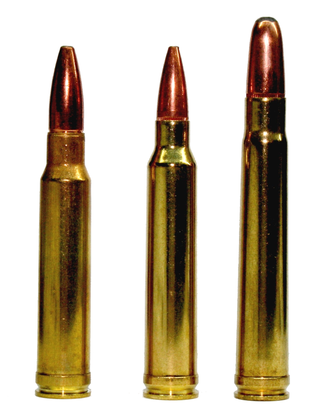
The .300 Winchester Magnum is a belted, bottlenecked magnum rifle cartridge that was introduced by the Winchester Repeating Arms Company in 1963. The .300 Winchester Magnum is a magnum cartridge designed to fit in a standard rifle action. It is based on the .375 H&H Magnum, which has been blown out, shortened, and necked down to accept a .30 caliber (7.62 mm) bullet.
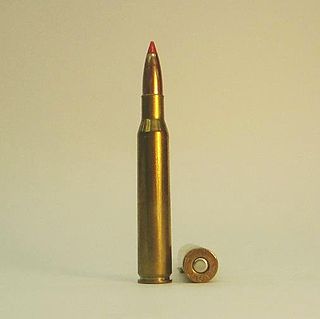
The .280 Remington, also known as the 7mm-06 Remington and 7mm Express Remington, was introduced in 1957 for the Remington model 740, 760, 721, and 725 rifles.

The 7mm Remington Magnum rifle cartridge was introduced as a commercially available round in 1962, along with the new Remington Model 700 bolt-action rifle. It is a member of the belted magnum family that is directly derived from the venerable .375 H&H Magnum. The original purpose of the belted magnum concept taken from the .300 H&H Magnum and .375 H&H Magnum, was to provide precise headspace control, since the sloping shoulders, while easing cartridge extraction, were unsuitable for this purpose. Improved cartridge extraction reliability is desirable while hunting dangerous game, in particular when a fast follow-up shot is required. The 7mm Remington Magnum is based on the commercial .264 Winchester Magnum, .338 Winchester Magnum, and .458 Winchester Magnum, which were based on the same belted .300 H&H Magnum and .375 H&H Magnum cases, trimmed to nearly the same length as the .270 Weatherby Magnum.

The 8mm Remington Magnum belted rifle cartridge was introduced by Remington Arms Company in 1978 as a new chambering for the model 700 BDL rifle. The 8mm Remington Magnum's parent case is the .375 H&H Magnum. It is a very long and powerful cartridge that cannot be used in standard length actions, such as those that accommodate the .30-06 Springfield.

The .35 Whelen is a powerful medium-bore rifle cartridge that does not require a magnum action or a magnum bolt-face. The parent of this cartridge is the .30-06 Springfield, which is necked-up to accept a bullet diameter of .358 in (9.1 mm). This cartridge is more powerful than its parent, especially in killing power on large game. However, with much wider availability, and the higher BC .30 caliber bullets of today, the power gap between the two cartridges has been decreased.
The .300 Remington Ultra Magnum, also known as the .300 Ultra Mag, 7.62×72mm or .300 RUM is a 7.62 mm rifle cartridge introduced by Remington Arms in 1999. The .300 Remington Ultra Magnum is one of the largest commercially available .30 caliber magnums currently being produced. It is a beltless, rebated rim cartridge, capable of handling all large North American game, as well as long-range shooting. Among commercially produced .30-caliber rifle chamberings, the .300 Remington Ultra Magnum is second only to the .30-378 Weatherby Magnum in cartridge-case capacity.

The 8×68mm S rebated rim bottlenecked centerfire rifle cartridge was developed in the 1930s by August Schüler of the August Schüler Waffenfabrik, Suhl, Germany as a magnum hunting cartridge that would just fit and function in standard-sized Mauser 98 bolt-action rifles. The bore has the same lands and grooves diameters as the German 7.92×57mm Mauser service cartridge. This is one of the early examples where a completely new rifle cartridge was developed by a gunsmith to fit a specific popular and widespread type of rifle.
The .260 Remington cartridge was introduced by Remington in 1997. Many wildcat cartridges based on the .308 Winchester case had existed for years before Remington standardized this round.
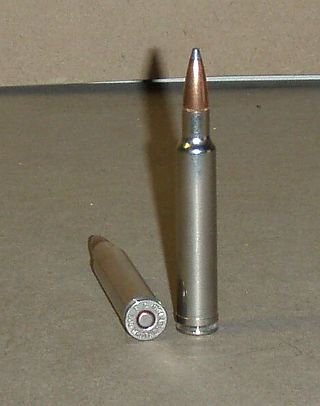
The .300 Weatherby Magnum is a .30 caliber rifle cartridge created by Roy Weatherby in 1944 and produced by Weatherby. It has become the most popular of all the Weatherby cartridges.

The .416 Remington Magnum is a .416 caliber (10.57 mm) cartridge of belted bottlenecked design. The cartridge was intended as a dangerous game hunting cartridge and released to the public in 1989. The cartridge uses the case of the 8 mm Remington Magnum as a parent cartridge. When the cartridge was released in 1988, author Frank C. Barnes considered the .416 Remington Magnum to be the "most outstanding factory cartridge introduced in decades".

The .284 Winchester is a cartridge that has enjoyed a resurgence due to interest from long-range competitive shooters. Winchester has continued to produce brass cases for this since 1963. Introduced by Winchester in 1963, the .284 Winchester was designed to achieve .270 Winchester and .280 Remington performance from the new Winchester Model 100 autoloader and Winchester Model 88 lever-action rifles.
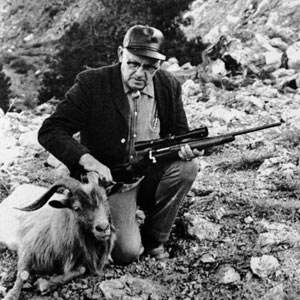
Parker Otto Ackley was an American gunsmith, barrel maker, author, columnist, and wildcat cartridge developer. The Ackley Improved family of wildcat cartridges are designed to be easily made by rechambering existing firearms, and fireforming the ammunition to decrease body taper and increase shoulder angle, resulting in a higher case capacity. Ackley improved not only standard cartridges, but also other popular wildcats, and was the first to create a .17 caliber (4.5 mm) centerfire cartridge.

The .375 Weatherby Magnum (9.5×73mmB) is a medium-bore rifle cartridge. The cartridge is blown out, improved and provided with the Weatherby double radius shoulder – given the Weatherby treatment – version of the .375 H&H Magnum. Unlike other improved versions of the .375 H&H Magnum like the .375 Ackley Improved, the .375 Weatherby Magnum is not a wildcat and existed as a proprietary cartridge until the CIP published specifications for the cartridge.
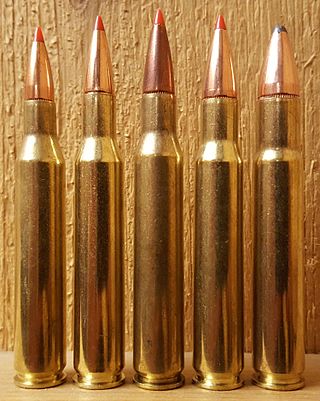
.30-06 Springfield wildcat cartridges are cartridges developed from a 30-06 Springfield "parent cartridge" through narrowing or widening the cartridge neck to fit a smaller or larger bullet in an attempt to improve performance in specific areas. Such wildcat cartridges are not standardized with recognized small arms standardization bodies like the SAAMI and the CIP.

Nosler produces six different hunting cartridges. The first to be introduced was .26 Nosler, followed by .28 Nosler, .30 Nosler, .33 Nosler, .22 Nosler, and .27 Nosler.
References
- 1 2 "MAXIMUM CARTRIDGE / MINIMUM CHAMBER" (PDF). Archived from the original (PDF) on 2011-07-26. Retrieved 2011-04-19.
- ↑ "cpcartridge index". Archived from the original on 2011-05-25. Retrieved 2011-04-28.
- ↑ "Rifles". Archived from the original on 2010-08-21. Retrieved 2011-04-19.